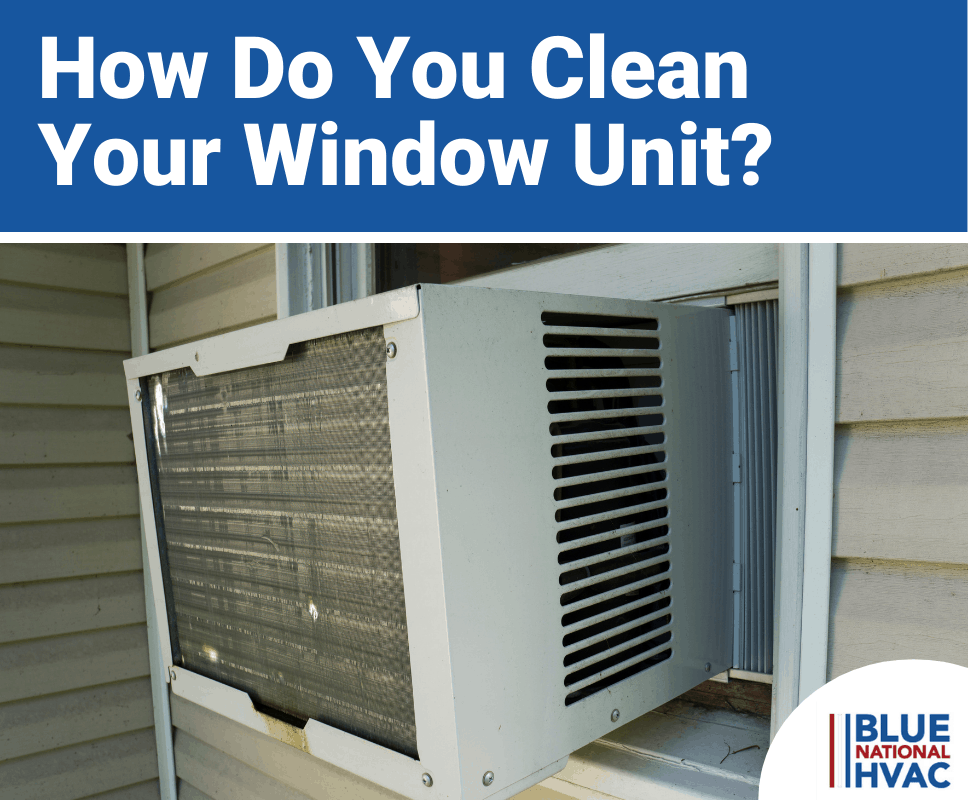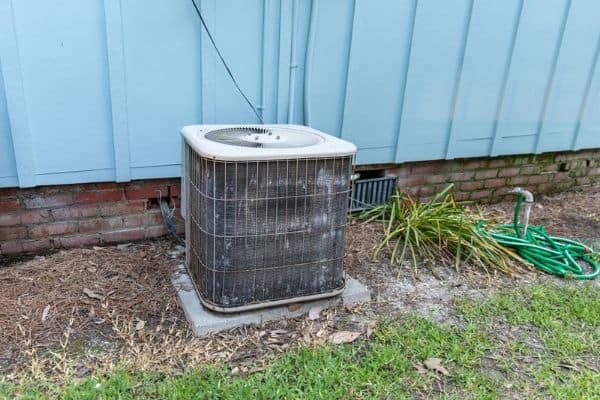And much more!
So, if you’re looking to learn how to clean an air conditioner, keep reading our detailed guide below to get answers to all of your questions!
How Do You Clean a Window AC Unit?
Window air conditioning systems are excellent and affordable ways to keep a room in your house, condo, or apartment cool in comfortable during the warm months of the year.
They are more simple in design than central air systems. However, they require just as much maintenance and routine cleaning as their more complex counterparts.
Cleaning your window air conditioner will not only make it look prettier, but it will also improve the air quality and perhaps even your health.
Before you start cleaning your window AC unit, make sure you turn it off. This doesn’t just mean hitting the “power” button, it means unplugging it entirely from the wall.
You don’t want to get shocked or electrocuted while you’re doing maintenance on your AC unit.
Luckily, your window AC unit can be (almost) completely cleaned from the inside of your house. However, generally, the two things you need to clean from the exterior are the AC unit’s surface and the condenser coils.
Obviously, this is sometimes not a viable option if you have installed it in the second-floor window or higher if you live in a tall building and you don’t want to take it out of the window and risk dropping it.
Just be sure to use your best judgment and if you live in a rental property, contact your property manager about how to clean the exterior parts.
Here are some materials you will need to clean your window air conditioner properly:
Vacuum Cleaner
Preferably use a vacuum with a soft brush attachment to vacuum up dust and grime.
Soft Bristle Brush
If you don’t have a brush vacuum attachment (a new toothbrush would work) you can use a bristle brush to dust off caked-on grime.
Spray Bottle
You can use this to clean the coils and other components.
Bucket
Use this to fill with warm, soapy water to help you break down grime.
Water, Dishwashing Soap, Bleach, Or Vinegar
This will be used to clean various components and strip off anything that the brush or vacuum can’t get.
Fin Comb (Optional)
This can be used to straighten fins on the condenser and evaporator. Just use this with caution if you’re inexperienced and if you have any hesitation when it comes to straightening fins, be sure to reach out to one of our professional technicians.
A Towel
Use this to soak up excess water.
Screwdriver
This will be used to unscrew the AC unit cover.
Latex or Nitrile Gloves
Use these to protect your hands from dust and bleach.
Once you have all these materials gathered and the power off, you can begin disassembling your window air conditioner and start cleaning it from inside.
You should plan to set aside around 30 to 60 minutes to clean your window air conditioner. If this is your first time cleaning one, you should plan closer to 60 minutes and perhaps longer. Once you get the hang of it, you’ll speed right through it.
Consult Your Window AC Unit’s Manual for Cleaning Instructions
Not all window AC units are the same. The below cleaning instructions serve as general “how to clean” guidelines.
The specific system you own might have slightly different disassembly steps.
Since all window AC systems differ, t’s best to consult the manual for proper cleaning instructions. If you no longer have the user manual, type your model number into Google search with “+ user manual” next to it.
The manual should have a step-by-step guide on removing the cover, cleaning, and reassembling the pieces if you need help.
What Is The Step-By-Step Process To Cleaning Your Window AC Unit?
Now that we’ve covered the basics, let’s walk through the step-by-step process for cleaning your window AC unit.
Step 1 – Remove and Clean the Front Panel of the Window AC Unit
To gain access to the filter of your window AC unit, you have to remove the cover. Again, since every model is different, it may snap off with clip releases, fold-down, or slide left or right to open or remove the cover.
The cover should be easy to remove, so don’t use a ton of force and break something. If you can’t figure out how to get it off, consult the user manual for instructions.
If your air conditioner filter is clogged and dirty, there’s a strong chance the grille on the front of your window AC unit is dirty too. The easiest way to clean the cover is to take it outside and hose it off. You can also use a sponge and mild detergent in your sink or bathtub.
However, if the temperature control module is physically connected to the cover, you’ll need to remove it. They are usually attached with screws. So, just unscrew those with a screwdriver and pop the control panel off.
Step 2 – Remove and Clean the Window AC Unit’s Filter
Once you have the grill off, you can remove the filter. Behind the filter, you will see the evaporator coils (we’ll explain how to clean those next). Inspect the filter.
If it has holes and looks broken, it is time to get a new one. You’ll need to get a replacement that fits your AC unit.
Look on the filter, the air conditioner, or the user manual to determine the specifications for the correct replacement and order one.
If your filter looks good but just dirty- use your vacuum cleaner with the brush attachment to clean the filter. If there’s a significant buildup of grime and gunk caked onto the filter, you can clean the filter with warm water and a few drops of mild detergent.
Let it soak in your bucket, tub, or large sink for a few hours, then wipe it off and let it air dry completely before putting it back into your window AC unit (or set it aside until you’re finished cleaning the inside of the AC unit).
Step 3 – Cleaning the Window AC Case
If you’re not removing your window AC unit from the window, you won’t be able to remove the case. However, you might be able to remove the AC components from the case. Depending on the design of your AC unit, it could pull out much like a desk drawer.
If this is the case with your AC unit, you’ll be able to clean the inside of the case with a damp towel and mild detergent (you may have to use some elbow grease), then dry with another towel.
With this type of design, you’ll also be able to remove the drawer and get easier access to the condensate drawing pan and condenser coils for cleaning.
Step 4 – Clean the Evaporator Coils of the Window AC Unit
The evaporator coils of your window AC unit are directly behind the filter. The coils are covered with evaporator fins that the air flows through to transfer heat from the air to cool it.
Since air is constantly being rushed through the evaporator coils, dust and additional debris are carried with it, which are then caught by the AC filter. If the AC filter becomes too dirty, the dust and particulates will back up into the evaporator coil and fins.
To clean the dust off the evaporator fins and coils, use a vacuum cleaner with a bristle brush attachment. You’ll want to be gentle on the fins since they can easily bend, which will block airflow and reduce the AC unit’s efficiency.
After you are done vacuuming the evaporator coils and fins, there might still be some caked-on dust and grime. You can use a spray bottle filled with warm, soapy water to clean it further. Put a towel underneath the evaporator coils to catch the runoff water and soap.
Let the moisture soak in. Then, you can lightly scrub the fins with a soft bristle brush and whip it away with a moist towel.
After (and while) you’re cleaning the evaporator coils would be a good time to inspect the fins to see if they are already bent. If they are bent, there’s a tool to straighten them, which we will touch on later.
Step 5 – Clean the Drain Pan and Condenser Coils
If you’re lucky and have a window AC unit that pulls out of the case like a drawer, cleaning your drain pan without removing the AC unit from the window will be easy.
If there’s moisture in the drain pan, soak it up with some paper towels and spray some warm and soapy water in the pan. After you let it sit for a while, wipe it clean with a moist towel. If water sits idle in your drain pan too long, it can foster mold growth and lead to a clog and poor air quality.
The condenser coils might be harder to reach. If you have access through the inside of the window AC unit, clean them the same way as the evaporator coils. Otherwise, you should be able to access the air conditioner coils on the outside of your window- just remove the cover to clean it.
Cleaning the outside of the window AC unit might not be an option for you, mainly if it is installed on the 2nd floor or higher. The only other option at that point would be to remove it from the window. We know that removing a window AC unit for routine cleanings is tricky- if you need assistance, give us a call!
Once you finished scrubbing your entire window air conditioner to a shine (and it’s dry), you can reassemble it and power it back on.
When and How Often Should You Clean Your Window AC Unit?
Your window AC unit should be cleaned at least every six months. If you live in an area with subpar air quality, if people smoke in your home, or if there’s a lot of dust blowing around outside of your home, you will probably have to clean it more often.
The rule of thumb for filters is to clean or replace them every six months. However, you should do a checkup on your AC unit about once a month and do just a quick monthly cleaning.
All you’ll have to do is quickly open the cover and inspect the filter, coils, and condensate tray. If everything looks clean, then you’re good to put everything back into place. If it’s dirty, you should do a quick spot cleaning.
Lastly, if you smell mold or mildew, that’s a sure sign you’ll need to clean your window AC unit STAT!
What Shouldn’t You Do While Cleaning a Window AC Unit?
The main thing you should avoid while cleaning your air conditioner are listed below:
- Don’t mix ammonia and bleach while you’re cleaning components (this can be fatal to you)
- Never leave your window AC unit plugged in while you’re cleaning it
- Limit excessive force when removing covers and panels. They should snap or slide off easily
- Don’t push too hard on the evaporator fins; you can bend them
- Let everything dry before reassembling your AC unit and plugging it back it
- Don’t use harsh solvents or cleaning chemicals inside your window AC unit
Always use common sense while cleaning your window air conditioner. When in doubt, consult your owner’s manual or give us a call for help.
How Do You Keep Your Window Air Conditioner Clean?
Keeping your window AC unit clean will help you avoid time-consuming cleaning sessions in the future. These checks all aim to save you time and keep your AC unit running smoothly.
Routine Check-Ups
About every month, check the filter of your window AC unit for excess dust (and give it a quick cleaning). Also, look behind the filter and evaporator coil for signs of mold, mildew, or stagnant water.
If you see anything alarming, clean it right away. Cleaning mold early will prevent a much more extensive mold problem.
Use a Fin Comb to Straighten Evaporator Fins
A fin comb is designed to straighten your condenser and evaporator’s fins and knock off any remaining dirt.
Keeping your fins straight ensures it does not track dust and particulates, which helps keep your AC unit cleaner.
A fin comb can be purchased at a local HVAC contractor store or through an online retailer.
The fins on both the condenser and the evaporator are aligned in rows. To straighten them, brush the fin comb “with the grain” so that the fins’ teeth fit between the fins. Then brush it like hair! This brushing motion should force the fins straight.
If you’d rather not buy a fin comb to straighten the fins yourself, give us a call! We’ll be able to send one of our experienced HVAC pros out to help.
Keep it Running
Keeping your AC unit running may sound counterintuitive since running your window air conditioner more often costs you more money, but a running air conditioner prevents stagnant water from sitting too long.
If there’s water sitting inside your AC unit for weeks or months, the dark, moist environment is the perfect harbor for mold spores to flourish. Plus your electricity bills won’t increase that much since a clean air conditioner runs more efficiently.
Store it Away in the Winter
Let’s face it, window AC units are hefty and challenging to install and remove. However, if you can take out your AC unit from the window in the cold months, this will help keep it clean. Before you store it away, you should give it a deep cleaning. It’ll be like new when you re-install it next season!
For assistance in installing or removing a window AC unit, give us a call! Our HVAC professionals can get yours installed in 15 minutes or less!
What Are The Benefits of a Clean Window Air Conditioner?
A clean window AC unit means that it is also pumping clean (and cool) air into your living space. Filters clogged with dust, bacteria, viruses, mold, and mildew are of no benefit to the air quality and can easily result in breathing issues and illnesses.
A clogged filter also reduces airflow through the evaporator fins. If they are blocked too long, this could result in your coil freezing. Routinely cleaning your window AC unit’s air filter will make it run more efficiently and save you money on your energy bill while increasing the lifespan of your unit. It will also be quieter since it won’t have to work so hard.
Cleaning the fins and straightening them with a fin comb also provide improvements in air flow, system efficiency, and noise reduction.
If you are routinely cleaning your AC unit, you’ll be able to find any mold issues right away. Mold loves to grow in dark, humid environments, which is exactly what the inside of an AC unit provides. If you see anything that looks like mold or if your AC unit is leaking directly onto your carpet, you should consider a professional mold removal service.
You can try to clean the mold yourself, but there are risks associated with that (like breathing it in), and if you don’t do it right, that mold can regrow quickly. Mold is a tricky pest to take care of, which is why it’s best left to the experts.
Does Your Window AC Unit Need a Repair or Replacement?
If you are giving your window air conditioner a cleaning because it is not cooling your room anymore or providing less cooling, there may be a more extensive issue with it. If the deep cleaning of your window AC unit did not provide any improvements to the cooling it provides, you might need it repaired or replaced.
Because window units are generally inexpensive, it is most often not economical to repair a window air conditioner. If a complex repair is required, that would very often require labor and component costs that could easily exceed the price of a new window AC unit.
However, if you think it is a minor issue that could be fixed quickly, by all means, give our HVAC experts a call, and we’ll walk you through some troubleshooting and let you know if a repair is an option or if you should replace it.

When Should You Hire A Professional To Clean Your Window Air Conditioner?
If you are not comfortable with disassembling your window air conditioning unit to clean it, you can leave that up to our professionals.
Our seasoned experts will get your window AC unit professionally cleaned for a fair rate. If your window air conditioner needs deep cleaning and fin straightening, don’t hesitate to call us at Blue National HVAC today!









